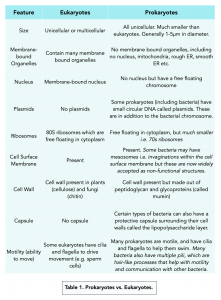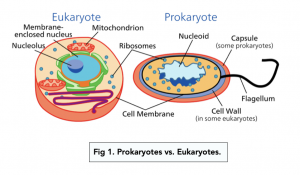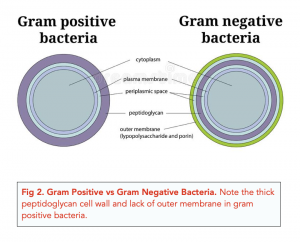Structure of Prokaryotic Cells (A-level Biology)
Structure of Prokaryotic Cells
Unlike eukaryotic organisms, prokaryotic cells are unicellular i.e. made up of a single prokaryotic cell. Bacteria are examples of prokaryotic organisms. The table below summarises the key differences between eukaryotes and prokaryotes.
Structure of Prokaryotes vs Eukaryotes


Gram Negative vs Gram Positive Bacteria
When studying bacteria under microscopes, scientists often perform a “gram stain” test, a staining technique used to quickly categorise bacteria into two groups based on the properties of their cell wall. Bacteria can either be classified as gram positive or gram negative.
There are a few bacteria that cannot be classified using this method (e.g. the bacteria Mycobacterium tuberculosis which causes tuberculosis) but they are in the minority and are known as atypical bacteria.
Gram Positive Bacteria
- Gram positive bacteria have a thick cell wall that retains the stain. During gram staining, a purple coloured stain called the “crystal violet” stain is first used to dye the sample. This is then washed away afterwards. If the bacteria has a thick peptidoglycan cell wall, it will retain the crystal violet stain despite it being washed away from the rest of the sample. These bacteria are known as gram positive bacteria.
Gram Negative Bacteria
- Gram negative bacteria have a thin cell wall and two cell membranes. Gram negative bacteria are called as such because they do not retain the crystal violet stain. This is because they have a thin peptidoglycan cell wall. Instead, they have a protective outer lipopolysaccharide membrane before the cell wall, and another inner plasma cell membrane after.

Antibiotic susceptibility
- Gram positive bacteria are susceptible to antibiotics which target the cell wall. As gram positive bacteria lack the outer protective lipopolysaccharide capsule, its cell wall is exposed. As such, antibiotics which target bacteria cell wall are easily able to penetrate the cell wall of gram positive bacteria and disrupt its structure.
Prokaryotic cells are single-celled organisms that lack a nucleus and other membrane-bound organelles. They are typically smaller and simpler in structure compared to eukaryotic cells.
A prokaryotic cell is made up of a cell wall, cytoplasmic membrane, cytoplasm, and genetic material in the form of a single, circular chromosome. Some prokaryotic cells also contain additional structures such as a capsule, flagella, and pili.
The cell wall of a prokaryotic cell provides protection and support to the cell. It also helps to maintain the shape and prevent the cell from bursting due to changes in pressure or osmotic stress.
The cytoplasmic membrane, also known as the plasma membrane, is a thin barrier that separates the cytoplasm from the external environment. It controls the movement of materials into and out of the cell and also serves as a source of energy for the cell.
The cytoplasm of a prokaryotic cell is where all of the metabolic processes occur. It contains a variety of enzymes, ribosomes, and other structures that are involved in metabolic reactions.
The genetic material in a prokaryotic cell is organized as a single, circular chromosome. This chromosome is located in the cytoplasm and is not enclosed by a nuclear membrane.
Prokaryotic cells lack membrane-bound organelles, but some contain additional structures such as a capsule, flagella, and pili. These structures perform various functions such as providing protection, aiding in movement, and facilitating adhesion to surfaces.
The simplicity of the structure of prokaryotic cells allows them to carry out all of their functions in a small, efficient manner. This makes them well-suited to survival in a variety of environments, including extreme conditions where other forms of life would not be able to survive.






Still got a question? Leave a comment
Leave a comment